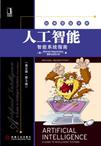人工智能
出版时间:2011-9 出版社:机械工业出版社 作者:(澳)Michael Negnevitsky 页数:479
Tag标签:无
前言
The main objective of the book remains the same as in the first edition - to provide the reader with practical understanding of the field of computer intelligence. It is intended as an introductory text suitable for a one-semester course, and assumes the students have only limited knowledge of calculus and little or no programming experience. In terms of the coverage, this edition introduces a new chapter on data mining and demonstrates several new applications of intelligent tools for solving complex real-world problems. The major changes are as follows: In the new chapter, 'Data mining and knowledge discovery', we introduce data mining as an integral part of knowledge discovery in large databases. We consider the main techniques and tools for turning data into knowledge, including statistical methods, data visualisation tools, Structured Query Language, decision trees and market basket analysis. We also present several case studies on data mining applications. In Chapter 9, we add a new case study on clustering with a self-organising neural network. Finally, we have expanded the book's references and bibliographies, and updated the list of AI tools and vendors in the appendix. Michael Negnevitsky Hobart, Tasmania, Australia September 2010
内容概要
人工智能经常被人们认为是计算机科学中一门高度复杂甚至令人生畏的学科。长期以来人工智能方面的书籍往往包含复杂矩阵代数和微分方程。本书基于作者多年来给没有多少微积分知识的学生授课时所用的讲义。假定读者没有编程经验,以简单易懂的方式介绍了智能系统的基础知识。
尼格尼维斯基编著的《人工智能》目前已经被国际上多所大学(例如,德国的马格德堡大学、日本的广岛大学、美国的波士顿大学和罗切斯特理工学院等)采纳为教材。
如果您正在寻找关于人工智能或智能系统设计课程的浅显易懂的入门级教材,如果您不是计算机科学领域的专业人员而又正在寻找介绍基于知识系统最新技术发展的自学指南,本书将是您的最佳选择。
与上一版相比,本版进行了全面更新,以反映人工智能领域的最新进展。其中新增了数据挖掘与知识发现一章和自组织神经网络聚类一节内容。同时补充了4个新的案例研究。
作者简介
澳大利亚塔斯马尼亚大学电气工程和计算机科学系教授。他的许多研究课题都涉及人工智能和软计算。他一直致力于电气工程、过程控制和环境工程中智能系统的开发和应用,发表了300多篇论文,著有2本专著,并获得了4项发明专利。
书籍目录
Preface
Preface to the third edition
Overview of the book
Acknowledgements
1 Introduction to knowledge-based intelligent systems
1.1 Intelligent machines, or what machines can do
1.2 The history of artificial intelligence, or from the Dark
Ages to knowledge-based systems
1.3 Summary
Questions for review
References
2 Rule-based expert systems
2.1 Introduction, or what is knowledge?
2.2 Rules as a knowledge representation technique
2.3 The main players in the expert system development team
2.4 Structure of a rule-based expert system
2.5 Fundamental characteristics of an expert system
2.6 Forward chaining and backward chaining inference techniques
2.7 MEDIA ADVISOR: a demonstration rule-based expert system
2.8 Conflict resolution
2.9 Advantages and disadvantages of rule-based expert systems
2.10 Summary
Questions for review
References
3 Uncertainty management in rule-based expert systems
3.1 Introduction, or what is uncertainty?
3.2 Basic probability theory
3.3 Bayesian reasoning
3.4 FORECAST: Bayesian accumulation of evidence
3.5 Bias of the Bayesian method
3.6 Certainty factors theory and evidential reasoning
3.7 FORECAST: an application of certainty factors
3.8 Comparison of Bayesian reasoning and certainty factors
3.9 Summary
Questions for review
References
4 Fuzzy expert systems
4.1 Introduction, or what is fuzzy thinking?
4.2 Fuzzy sets
4.3 Linguistic variables and hedges
4.4 Operations of fuzzy sets
4.5 Fuzzy rules
4.6 Fuzzy inference
4.7 Building a fuzzy expert system
4.8 Summary
Questions for review
References
Bibliography
5 Frame-based expert systems
5.1 Introduction, or what is a frame?
5.2 Frames as a knowledge representation technique
5.3 Inheritance in frame-based systems
5.4 Methods and demons
5.5 Interaction of frames and rules
5.6 Buy Smart: a frame-based expert system
5.7 Summary
Questions for review
References
Bibliography
6 Artificial neural networks
6.1 Introduction, or how the brain works
6.2 The neuron as a simple computing element
6.3 The perceptron
6.4 Multilayer neural networks
6.5 Accelerated learning in multilayer neural networks
6.6 The Hopfield network
6.7 Bidirectional associative memory
6.8 Self-organising neural networks
6.9 Summary
Questions for review
References
7 Evolutionary computation
7.1 Introduction, or can evolution be intelligent?
7.2 Simulation of natural evolution
7.3 Genetic algorithms
7.4 Why genetic algorithms work
7.5 Case study: maintenance scheduling with genetic algorithms
7.6 Evolution strategies
7.7 Genetic programming
7.8 Summary
Questions for review
References
Bibliography
8 Hybrid intelligent systems
8.1 Introduction, or how to combine German mechanics with
Italian love
8.2 Neural expert systems
8.3 Neuro-fuzzy systems
8.4 ANFIS: Adaptive Neuro-Fuzzy Inference System
8.5 Evolutionary neural networks
8.6 Fuzzy evolutionary systems
8.7 Summary
Questions for review
References
9 Knowledge engineering
9.1 Introduction, or what is knowledge engineering?
9.2 Will an expert system work for my problem?
9.3 Will a fuzzy expert system work for my problem?
9.4 Will a neural network work for my problem?
9.5 Will genetic algorithms work for my problem?
9.6 Will a hybrid intelligent system work for my problem?
9.7 Summary
Questions for review
References
10 Data mining and knowledge discovery
10.1 Introduction, or what is data mining?
10.2 Statistical methods and data visualisation
10.3 Principal component analysis
10.4 Relational databases and database queries
10.5 The data warehouse and multidimensional data analysis
10.6 Decision trees
10.7 Association rules and market basket analysis
10.8 Summary
Questions for review
References
Glossary
Appendix: AI tools and vendors
index
章节摘录
版权页:插图:The first work recognised in the field of artificial intelligence (AI) was presentedby Warren McCulloch and Walter Pitts in 1943. McCulloch had degrees inphilosophy and medicine from Columbia University and became the Director ofthe Basic Research Laboratory in the Department of Psychiatry at the Universityof Illinois. His research on the central nervous system resulted in the first majorcontribution to AI: a model of neurons of the brain. McCulloch and his co-author Walter Pitts, a young mathematician, proposeda model of artificial neural networks in which each neuron was postulated asbeing in a binary state: that is, in either an on or off condition (McCulloch andPitts, 1943). They demonstrated that their neural network model was, in fact,equivalent to the Turing machine, and proved that any computable functioncould be computed by some network of connected neurons. McCulloch and Pittsalso showed that simple network structures could learn.
编辑推荐
《人工智能:智能系统指南(英文版)(第3版)》为经典原版书库之一。
图书封面
图书标签Tags
无
评论、评分、阅读与下载
用户评论 (总计4条)
- 外国人写的书和中国人写的 就是不一样
- 与人工智能相关的算法和应用都有涉及,具备相关知识背景的人读起来不太费劲,对于理解这个学科和相关算法的内涵以及适用场合有很大的帮助。 若是作为教材,应该是相当合适了,帮助你从总体上把握相关的方法和理论,具体应用的话,你知道如何去选择。
- 需要什么基础么?
- 这本书本身就是基础
推荐图书
- 換個英語腦!
- 職場救兵--九型人格攻心術
- 現代商業銀行實務
- 魔女嘉莉
- 股壇解碼器
- 管理类专业学位联考综合能力考试历年真题与典型题详解
- 新古典主义
- 如何与大人物打交道
- 11全能学练教材1+1*三年级数学上*苏教
- 高层建筑课程设计
- 11全能学练教材1+1*五年级数学上*苏教
- 世界室内设计
- 世界室内设计·餐饮空间
- 世界室内设计
- 11全能学练教材1+1*四年级数学上*苏教
- 被遗弃的人
- 汉上书画2011(总第一辑)
- 武昌老地名
- 鸽子行动
- 翻譯學導論
- “亮剑高考”英语精讲系列丛书
- 武昌老地名
- JAZZ WHAT? 爵士入門
- 中國文化的傳承與開拓
- 中人版-国家保安员资格考试通用题库下册 国家保安员资格考试冲刺过关命题预测试卷
